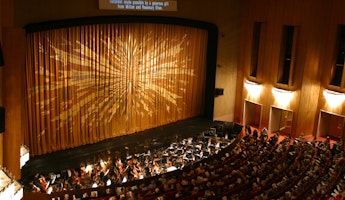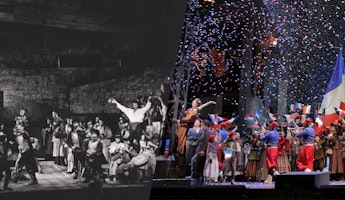Blog
April 6, 2022
Approaching Aida: Francesca Zambello
The grandest of grand operas makes its long-awaited return to our stage for the first time in 16 years. Aida, Verdi's iconic masterpiece, opens May 21, 2022 with a spectacular production from director Francesca Zambello. The internationally recognized director conjures a gorgeous world where street art-inspired hieroglyphics create a striking backdrop to the sensational story.
Francesca recently sat down with our CEO Christopher Koelsch for a conversation on her artistic approach to this production and the unique world she created for it.
CK: HOW DID YOU START TO BUILD THE DESIGN CONCEPT FOR AIDA WITH YOUR COLLABORATORS?
FZ: Actually, a lot of credit goes to you, Christopher. I want to say that right up front. We were talking about Aida just philosophically and you mentioned an LA-based artist named RETNA and said, “Have you ever seen this guy's stuff?” And he showed me a picture of it. And I was like, “wow, maybe that's a solution.” Because a lot of RETNA’s lingua is his version of hieroglyphics. So I wrote him a letter and I said, “Can we do Aida and do it with all this stuff?” And at that time, [Aida] wasn't in [LA Opera’s] planning. I took the idea to [San Francisco Opera’s] David Gockley and said that I think this is a way into Aida, visually, that will satisfy people who think the production has to involve Egypt, but also give us a contemporary viewpoint and a way to tell the story.
So we started the production in San Francisco with RETNA. He designed the artwork and then set designer Michael Yeargan translated it into scenery. Anita Yavich did the costumes and the lighting is by Mark McCullough. One of the things that is very important in the piece is dance. Dance is a huge part of the work. And so I went to Jessica Lang and I asked her to do Aida. I wanted the dance to really take over the ceremonial part of the opera.
The opera has a lot of what you would consider “religious-as-ceremonial.” And often that is related to something Egyptological—but Verdi didn't know about Egypt. So why don't we create our own language? Let’s create our own visual language with the set, and then create our own movement with the dance.
I also wanted the conflict of the piece to feel more like a civil crisis and show that through the set and costumes. There are the northern people who are the sort of wealthier, more powerful people, who are all dressed in green and purple and very lavish colors, which is Amneris and the King, of course. And Aida and her father are also in those greens and purples.
It was really a question of creating these spaces with RETNA, which feel modern and historic at the same time, and costumes that are long and beautiful and flowing for the women and, for the men, that are suggestive of uniforms or of religious priests. So it was about creating our own language for all these things.
CK: WHAT IS THE DESIRE IN THE END? WHEN YOU WANT SOMETHING TO, AS YOU SAY, KIND OF BE MODERN OR RESONATE WITH A MODERN AUDIENCE, WHAT'S BEHIND THAT DESIRE? IS IT A DESIRE AROUND ACCESS TO THE ART FORM OR AN AESTHETIC?
FZ: I think the question is great because those are the answers.
Aida—like Carmen, like La Bohème—has very recognizable aspects to it. But what I think makes it really different is that there is war at the center of that. It's a human drama surrounded by a war. In those other pieces, they don’t have to worry about war; their conflict is related entirely to human emotion, to love stories. That's why I think Aida is a little bit tricky. There's a war going on and you don’t want to downplay that, but you want to make that the background and you want to put the political drama in the front. And I think political dramas lend themselves to feeling contemporary.
I like that there's an element of ceremony in this and also the abstract, which the visual really gives us. And I hope that draws you into the story.
When you talk about accessibility, there are certain times where we merit sitting there for four and a half hours. And there are other times where we just think, “I want to go home at two hours and 40 minutes with one intermission.” So the piece only has one intermission, and that's not a statement about the quality of the music—the music is gorgeous. I think it's just the way we process this music and information, especially for someone who may be new to opera.
CK: THERE'S A HANDFUL OF REPERTORY PIECES THAT AUDIENCES HAVE A REALLY FIXED SENSE OF WHAT THE AESTHETICS NEED TO BE; EVEN IF THEY HAVEN’T SEEN IT, THEY HAVE A PICTURE IN THEIR HEAD OF WHAT IT IS AND WHAT IT LOOKS LIKE. DO YOU EVER WORRY THAT IF IT’S SOMEHOW AESTHETICALLY DISTINCT FROM WHAT PEOPLE ARE EXPECTING, YOU'RE SETTING YOURSELF UP FOR DISAPPOINTMENT OR FRUSTRATION FROM THE AUDIENCE?
FZ: It is a shrinking minority of people who say “It should be like this.” And I'm always like, “Oh, is that written down somewhere? Is that in the Bible? I mean, where is that written?” I think it's our collective job to be as true as possible to the composer and librettist’s intentions and to tell the story.
The way that we tell the story may upset some people. But Aida is timeless, and this story suggests a mythical time, which Verdi himself wanted. This production is stylish and visually strong with spectacular movement and music. You can feel its power from the stage. Yes, if people have seen Aida at the Arena di Verona or the classic Met production, this does not look like those. But it does create its own world.
I think for every audience member that wants to see a more traditional production, there are also some who don’t want to see the same thing. They want to see something new and different. But that’s where being true to the story and music come in, and that’s when I get up and say, “That’s my job.”
CK: AND I WOULD ACTUALLY ARGUE THAT YOU'VE GONE MUCH FURTHER THAN THAT. THAT YOU'VE ACTUALLY ENCOMPASSED THE PERFORMING HISTORY OF THE PIECE BY CREATING SPECTACLE ON STAGE. YOU TOUCHED ON THIS EARLIER, THAT THE BULK OF THE ACTUAL PIECE IS A HUMAN DRAMA AMONG A SMALL NUMBER OF PEOPLE, BUT THE ACTUAL, VISUAL WORLD THAT YOU'VE COME UP WITH IS COMPLETELY SPECTACULAR. IT’S NOT A CHAMBER AIDA IN THE SLIGHTEST.
FZ: No, definitely not. We’ve treated it as grandeur because it is. We invented our own world for this production, the same way that Verdi invented his own world when we wrote it. He never set foot in Egypt but look at what he created. I’m looking forward to seeing this world we’ve invented come together on stage.








/03-cosi/_dsc0996_pr.jpg?format=auto&fit=crop&w=345&h=200&auto=format)















